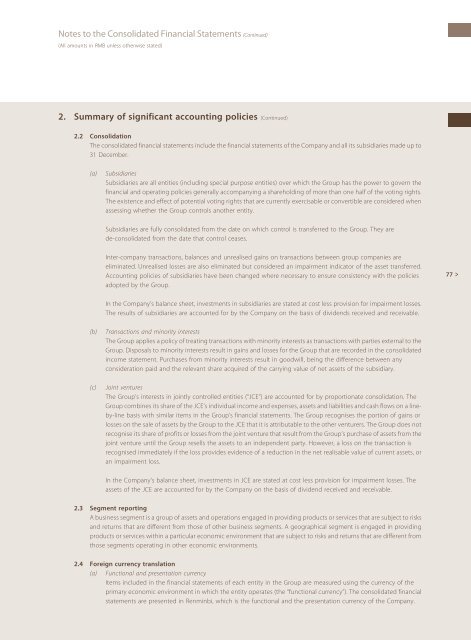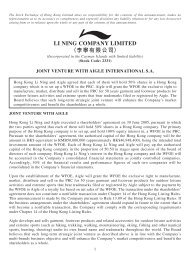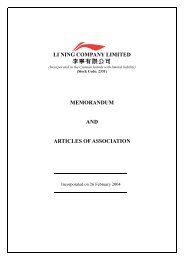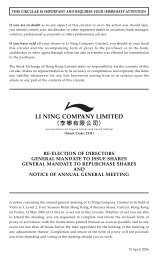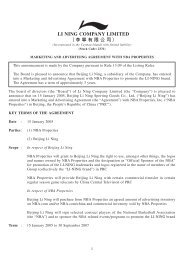Annual Report - Li Ning
Annual Report - Li Ning
Annual Report - Li Ning
- TAGS
- annual
- ning
- www.lining.com
Create successful ePaper yourself
Turn your PDF publications into a flip-book with our unique Google optimized e-Paper software.
Notes to the Consolidated Financial Statements (Continued)<br />
(All amounts in RMB unless otherwise stated)<br />
2. Summary of significant accounting policies (Continued)<br />
2.2 Consolidation<br />
The consolidated financial statements include the financial statements of the Company and all its subsidiaries made up to<br />
31 December.<br />
(a) Subsidiaries<br />
Subsidiaries are all entities (including special purpose entities) over which the Group has the power to govern the<br />
financial and operating policies generally accompanying a shareholding of more than one half of the voting rights.<br />
The existence and effect of potential voting rights that are currently exercisable or convertible are considered when<br />
assessing whether the Group controls another entity.<br />
Subsidiaries are fully consolidated from the date on which control is transferred to the Group. They are<br />
de-consolidated from the date that control ceases.<br />
Inter-company transactions, balances and unrealised gains on transactions between group companies are<br />
eliminated. Unrealised losses are also eliminated but considered an impairment indicator of the asset transferred.<br />
Accounting policies of subsidiaries have been changed where necessary to ensure consistency with the policies<br />
adopted by the Group.<br />
In the Company’s balance sheet, investments in subsidiaries are stated at cost less provision for impairment losses.<br />
The results of subsidiaries are accounted for by the Company on the basis of dividends received and receivable.<br />
(b) Transactions and minority interests<br />
The Group applies a policy of treating transactions with minority interests as transactions with parties external to the<br />
Group. Disposals to minority interests result in gains and losses for the Group that are recorded in the consolidated<br />
income statement. Purchases from minority interests result in goodwill, being the difference between any<br />
consideration paid and the relevant share acquired of the carrying value of net assets of the subsidiary.<br />
(c) Joint ventures<br />
The Group’s interests in jointly controlled entities (‘‘JCE’’) are accounted for by proportionate consolidation. The<br />
Group combines its share of the JCE’s individual income and expenses, assets and liabilities and cash flows on a lineby-line<br />
basis with similar items in the Group’s financial statements. The Group recognises the portion of gains or<br />
losses on the sale of assets by the Group to the JCE that it is attributable to the other venturers. The Group does not<br />
recognise its share of profits or losses from the joint venture that result from the Group’spurchaseofassetsfromthe<br />
joint venture until the Group resells the assets to an independent party. However, a loss on the transaction is<br />
recognised immediately if the loss provides evidence of a reduction in the net realisable value of current assets, or<br />
an impairment loss.<br />
In the Company’s balance sheet, investments in JCE are stated at cost less provision for impairment losses. The<br />
assets of the JCE are accounted for by the Company on the basis of dividend received and receivable.<br />
2.3 Segment reporting<br />
A business segment is a group of assets and operations engaged in providing products or services that are subject to risks<br />
and returns that are different from those of other business segments. A geographical segment is engaged in providing<br />
products or services within a particular economic environment that are subject to risks and returns that are different from<br />
those segments operating in other economic environments.<br />
2.4 Foreign currency translation<br />
(a) Functional and presentation currency<br />
Items included in the financial statements of each entity in the Group are measured using the currency of the<br />
primary economic environment in which the entity operates (the ‘‘functional currency’’). The consolidated financial<br />
statements are presented in Renminbi, which is the functional and the presentation currency of the Company.<br />
77 >


